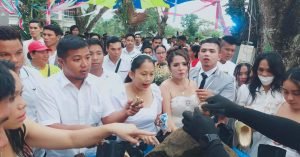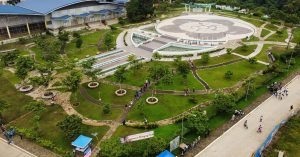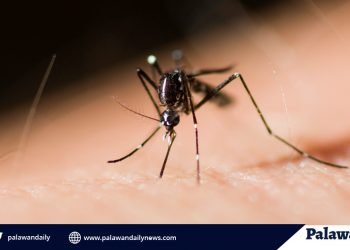The City Government of Puerto Princesa emphasized the need to deal with the diminishing green spaces in urban areas by planting more trees to combat the effects of rising temperature and climate change.
In April 2023, this city recorded a scorching 43 degrees Celsius heat index. Scientists associate rising temperatures to Urban Heat Island (UHI) which occur when cities replace natural land cover with dense concentrations of pavement, buildings, and other surfaces that absorb and retain heat. It results in an increase in energy costs specifically for air conditioning, air pollution levels, and heat-related illness. Unregulated conversion of green spaces like forest, grasslands, and parks to residential subdivisions causes increasingly high temperatures in our cities. This has created UHI that can even worsen air pollution problems and increase energy requirements, among others.
This year’s Feast of the Forest locally known as Pista Y Ang Cagueban (PYAC) held on June 24, is shifting focus to urban forestry. The city’s biggest annual tree planting event has been held in urban areas instead of its traditional planting sites in upland forest areas since 1991.

PYAC attracts people from all walks of life, including those from the government and private sectors, students, uniformed personnel, businessmen, employees, religious and civic groups every year. Last September 2005, Puerto Princesa declared every last Saturday of June every year as PYAC through City Ordinance No. 286.
Based on official records of the City Environment and Natural Resources Office (City ENRO), PYAC has planted a total of 2.6 million trees from 1991 to 2022 in 16 sites within the city’s upland barangays.
Of the total trees planted from 1991 until present, roughly 70-80 percent is estimated to have survived and grown.

Starting this year, however, the city wants to address urban heat and high temperature within the city center through “PYAC Urban Edition.”
In the US scientific journal Environmental Pollution published in 2014 in the United States, “Tree and forest effects on air quality and human health” authored by David J. Nowak, Satoshi Hirabayashi, Allison Bodine, and Eric Greenfield, said that trees remove air pollution by the interception of particulate matter on plant surfaces and the absorption of gaseous pollutants through the leaf stomata. Trees in cities, especially native trees, help clean the air by removing carbon from the air, getting absorbed and stored as cellulose in their trunks, branches and leaves. This process is known as sequestration. With a good management of trees in the city, existing tree cover is sustained together with large, healthy trees. Planting trees within the city provide shade for parked cars, sidewalks, thus making the city more walkable and livable.

Despite being a city in the forest in the Philippines’ last ecological frontier, Puerto Princesa also experiences pressures due to rapid urbanization and increasing population. Its forested urban areas are lost to development.

Supports wildlife, birds and biodiversity
Aside from its PYAC, the city’s greening efforts has been supplemented and fortified by its urban forestry program that started in 2016. In this program, they focused on planting endemic, native or fruiting trees that supports biodiversity and wildlife such as Ingyam, Banaba, Narra, Bakawan Gubat, Agoho, Alalod, Balayong, Batino, Bignay, Bogo, Burawis, Dao, Kasoy, Langka, Malabagtik, Palawan Mangkono, Mulawin, Pangi, Pasi, Putian, Red Nato, Sahing, Siar, Tanabag, White Nato, among others.
One of the trees considered in the city’s urban forestry program is Narra, the country’s national tree, a hardwood described as reflecting the resiliency and strength of the Filipinos. Its leaves and flowers are fragrant and attract plenty of insects for pollination. Its fruit also attracts birds, rodents, and other small mammals on the rainforest floor. Other trees like Banaba that have wrinkled flowers that attract pollinators like bees. Bani too, with its canopy of bright green oval leaves and pink, white or purple flowers attract pollinators.
Inyam tree for instance, offered its fruits to birds.
Senior Environmental Management Specialist (SEMS) Forester Zorina C. Arellano of the City ENRO Forest Management Division said that native trees are linked to the well-being of the insects, birds and wildlife species that naturally occur in an area, thus it is important to consider the selection of native trees that supports wildlife and biodiversity like mammals, avian species, bees and others that form part of the biodiversity. Native trees should be planted and not the introduced species that are mostly invasive.
“Yung native trees sa area yun na ang dati nilang tirahan and other plant and wildlife species are dependent to them. Kasi pag invasive or introduced species, ma-dominate nila yung area at mawawala yung ibang trees. Yung (plant and wildlife) species that are dependent on other trees ay wala ng makain kasi iisa lang na species ang nag dominate. Ma-limit yung biodiversity [The native trees present in the area have thrived there for a long time already and other plants and wildlife are dependent on them. If invasive or introduced (tree) species are planted, it will dominate the area while other trees may vanish. Plants and wildlife species that are dependent on a variety of trees, might no longer survive because only one species dominates. It will limit the biodiversity],” she explained.
Urban Forestry Program is also considered as a boost to the city’s bird tourism and the annual birding event. In 2016, this city launched the International Bird Photography Race that attracted professional bird photographers coming from different parts of the country, as well as those from Taiwan, Hongkong, Malaysia, Thailand, Vietnam, Japan, United States, Costa Rica, etc. The yearly event, interrupted during the pandemic, is bringing more bird photographers and enthusiasts from different parts of the world to the event.
Birding is also a muti-million dollar industry in Central and South American countries of Brazil, Colombia, Costa Rica, Peru, etc. which will also contribute to the local economy. Wild Bird Photographers of the Philippines (WPBB) has nominated Puerto Princesa as birding capital.
In holding international birding events, this city does not fail birds enthusiasts as they were amazed by its rare and endemic birds. Among these wild birds are Palawan Flowerpecker (Prionochilus platen), Palawan Mangrove Blue Flycatcher (Cyornis rufigastra), Brown-throated Sunbird (Antheptes malacensis), Lovely Sunbird (Aethopyga shelleyi), Palawan Hornbill (Anthracoceros marchei), Blue Paradise Flycatcher (Terpsiphone cyanescens), Palawan Striped-Babbler (Zosterornis hypogrammicus) etc.
US tree technology help increase green spaces
The concept and implementation of Puerto Princesa’s Urban Forestry Program took an unprecedented leap after Atty. Carlo B. Gomez, the City Environment and Natural Resources Officer (City ENRO) attended the International Seminar on Urban Forestry sponsored by the United States Forest Service (USFS) in Chicago and New York, United States last June 2017. Since then, he was introduced to the iTree Eco.
The city’s urban forestry program is now supported by USFS-developed digital application known as i-Tree Eco. It is a tree analysis and assessment tool that provides data on tree’s benefits, such as carbon sequestration, carbon storage, oxygen production, avoided runoff, among others.

i-Tree Eco has been piloted in Puerto Princesa City’s public parks, privately-owned resorts, hotels and other accommodation establishments, public and private schools, etc., providing relevant ecosystem services data and information, including the ecosystem services of the trees in Philippine peso value. Recognizing its importance to other cities, Puerto Princesa’s i-Tree team shared its learnings to Iloilo and Tagbilaran, both USAID-Cities Development Initiative (CDI) assisted cities.
Atty. Gomez said that i-Tree is a mainstay project of the City ENRO. Since i-Tree was introduced in Puerto Princesa in 2016, their office has conducted tree assessments in several priority sites such as Plaza Cuartel, City Hall complex, Balayong People’s Park, Acacia Tunnel, schools, privately-owned hotels, resorts, among others.
i-Tree Eco is designed to use field data from complete inventories or randomly located plots throughout a community along with local pollution and meteorological data to quantify urban forest structure, environmental effect and value to communities. The field personnel will collect and encode data such as tree height, diameter forest height (DBH), base crown height, crown light exposure, species, among others, which will be interpreted by the i-Tree apps.
It is a freely available software that helps planners understand their urban forest resource and the ecosystem services it provides and use that information to support sustainable urban development and economic growth. Understanding urban forest’s structure, function and value can promote management decisions that will improve human health and environmental quality.
In a tree assessment conducted by the City ENRO team in September 2019 in Dang Maria, they inventoried a total of 380 trees of various species in a 1.3-hectare area, which is a portion of the private resort with tree cover.
For carbon storage, trees in Dang Maria are estimated to store 88.3 metric tons equivalent to 88,300 kg of carbon with an associated value of P844,000. In carbon sequestration, the gross sequestration of Dang Maria’s trees is about 6.221 metric tons or 6,221 kg of carbon per year with a value of P59,400.
Meanwhile, for oxygen production, trees in Dang Maria are estimated to produce 16.59 metric tons or 16,590 kg of oxygen per year. Also, the trees and shrubs of Dang Maria help to reduce runoff by an estimated 182 cubic meters a year with an associated value of P21,800 a year.
As part of their next steps, the City ENRO plans to develop a system to rate the environmental standings of tourism establishments based on the ecosystem services provided by the trees, a policy to encourage resort and hotel owners to dedicate a space for planting trees.
𝐁𝐚𝐥𝐚𝐲𝐨𝐧𝐠, 𝐭𝐡𝐞 𝐜𝐢𝐭𝐲’𝐬 𝐧𝐞𝐰𝐞𝐬𝐭 𝐩𝐚𝐫𝐤
The 7-hectare Balayong People’s Park is Puerto Princesa City’s newest park and the product of its Urban Forestry Project. Established in 2017, the Balayong People’s Park was developed as a green space where various outdoor activities could be held.
The 7-hectare park had been planted with over 1,200 Balayong (Palawan cherry blossom) trees. At least 400 of these were young trees that were saved from the city’s road expansion projects and had been earth-balled and transplanted in the park.

In 2019, the City Government spearheaded the Balayong Nurturing activity in which those who planted it will nurture their tree by removing weeds and watering it, ensuring its survival. The park is now equipped with facilities that include a tower view deck, waterpark, recreational and children’s parks, food complex, and artists’ pavilion, among other facilities.
Today, more than a thousand of Balayong bloomed. It is a tropical flowering tree believed to be native to Palawan. It bears white and pink flowers blooming from March to April. Although some researches and accounts claimed that the tree originated from neighboring Asian countries.
Aside from its Balayong Park, the city recently opened its Arboretum that houses both endemic and native trees serving as a center for research and bioreserve.
𝐌𝐢𝐭𝐢𝐠𝐚𝐭𝐢𝐧𝐠 𝐜𝐥𝐢𝐦𝐚𝐭𝐞 𝐫𝐢𝐬𝐤𝐬, 𝐚𝐝𝐝𝐫𝐞𝐬𝐬𝐢𝐧𝐠 𝐡𝐢𝐠𝐡 𝐭𝐞𝐦𝐩𝐞𝐫𝐚𝐭𝐮𝐫𝐞
The city government reiterated its commitment to aggressively pursue a forestry program, this time with a specific emphasis on the “re-greening” of schools and open spaces within urban centers.
Atty. Gomez emphasized the need to deal with high temperatures in school buildings which most of the students suffered. They started including school sites and open spaces in its urban forestry programs. At least eight schools were included this year as part of the program. Planting of trees within school yards will provide shade and coolants to teachers, parents and students, while providing them with other ecosystem services.
“Napakagandang halimbawa o panimula ang (urban) edition na ito na panibagong pamamaraan sa pag address ng climate change na ang pagtatanim ay dito gagawin sa kabayanan. Inuna natin mga eskwelahan, bakit eskwelahan? Kasi kalimitan ng mga nagsu-suffer ng urban heat yung mga estudyante natin especially mga public o private schools hindi naman airconditioned ang mga classrooms, by providing shades ay nakakatulong na bumaba ang temperatura sa mga school yards nila,” he explained.
Aside from its effort to include schools in its urban forestry project, they also eyed to convince the city housing project beneficiaries to plant at least one tree in their 100-150-square-meter lot area. The use of a small lot can be maximized with a design from the City Engineering Office or City Architect’s Office that will serve as guide to household owners thus optimizing their limited lot space to include parking space and area for trees.
A lot measuring 90 or 100 square meters can be maximized through vertical expansion of up to second or third floors, while still accommodating space for parking and also a space for a tree or trees. The roadsides in city housing subdivision areas are utilized as parking spaces. Providing a design for housing beneficiaries to consider enable them to plant trees within their lot, a can still accommodate a space for their vehicles. Trees and vegetation uplift the well-being of the people because of its environmental and aesthetic value, and the ecosystem benefits that it provides.
“Ang purpose ng socialized housing is to alleviate the social status of beneficiaries and yung pag-alleviate ng kanilang social status comes with the alleviation and protection of health. Kung walang ganitong design na urban forestry, kung hindi natin sasamahan ng ecosystem benefit ng mga puno natin, then kino-compromise lang natin yung ating mga (housing project) beneficiary [The purpose of socialized housing is to alleviate the social status of beneficiaries as well as to protect their health. Without these, then we are compromising the health and environmental benefit of our housing project beneficiaries],” Atty. Gomez further said.
He emphasized that the Urban Forestry Project of the city intends to help counter urban heat island effect and mitigate the effects of climate change. Urban heat island effect occurs when cities replace natural land cover with dense concentration of buildings, concrete roads, pavement, and other surfaces that absorb and retain heat. Based on his observations, most areas within Puerto Princesa City that register high temperatures are subdivisions with limited or no trees or vegetation.
“Isa sa mga e address sa Urban Forestry Project titingnan yung environmental health ng ating mga target recipients kasi kung papansinin mo sa liit ng area nila, sila ang nag register ng matataas na urban heat. Kawawa [One of the areas that Urban Forestry Project aim to address is the environmental health of the housing project recipients because as we have observed them, with their limited area, they register the hottest. Pitiful],” Atty. Gomez said.
He explained that one of the crucial local policies that will help in greening the city’s urban areas is the proposed landscape ordinance that will require builders, contractors or developers to plant trees in their open spaces.
“Ito yung magbibigay ng mandate at compulsory compliance ng ating mga builders tulad ng Camella, Sta. Lucia o Robinsons. Sa ngayon walang mandatory ordinance na (kailangang) mag adopt sila ng pagtatanim, except sa open space na mandatory requirement ni HLURB sa mga subdivisions [This will provide mandate and compulsory compliance to land developers like Camella, Sta. Lucia or Robinsons. As of now, there is no local ordinance that requires them to plant, except for the mandatory requirement set by LTFRB in subdivisions],” Atty. Gomez further explained.
The creation of a city housing council that will look into urban heat issues will help improve the conditions of the beneficiaries and ensure that each housing unit has at least one tree that will benefit them and the people in the community.
Mike Escote, who is the president of the city’s federation of homeowners association, welcomed this initiative to address increasing temperatures in areas where city’s housing projects are located.
Various stakeholders, the civil society and Puerto Princesa community’s active climate action is also focused on urban biodiversity, realizing that the urban area also has its richness not only in its flora and fauna that need to be safeguarded from environmental pressures caused by rapid urbanization.
























Discussion about this post